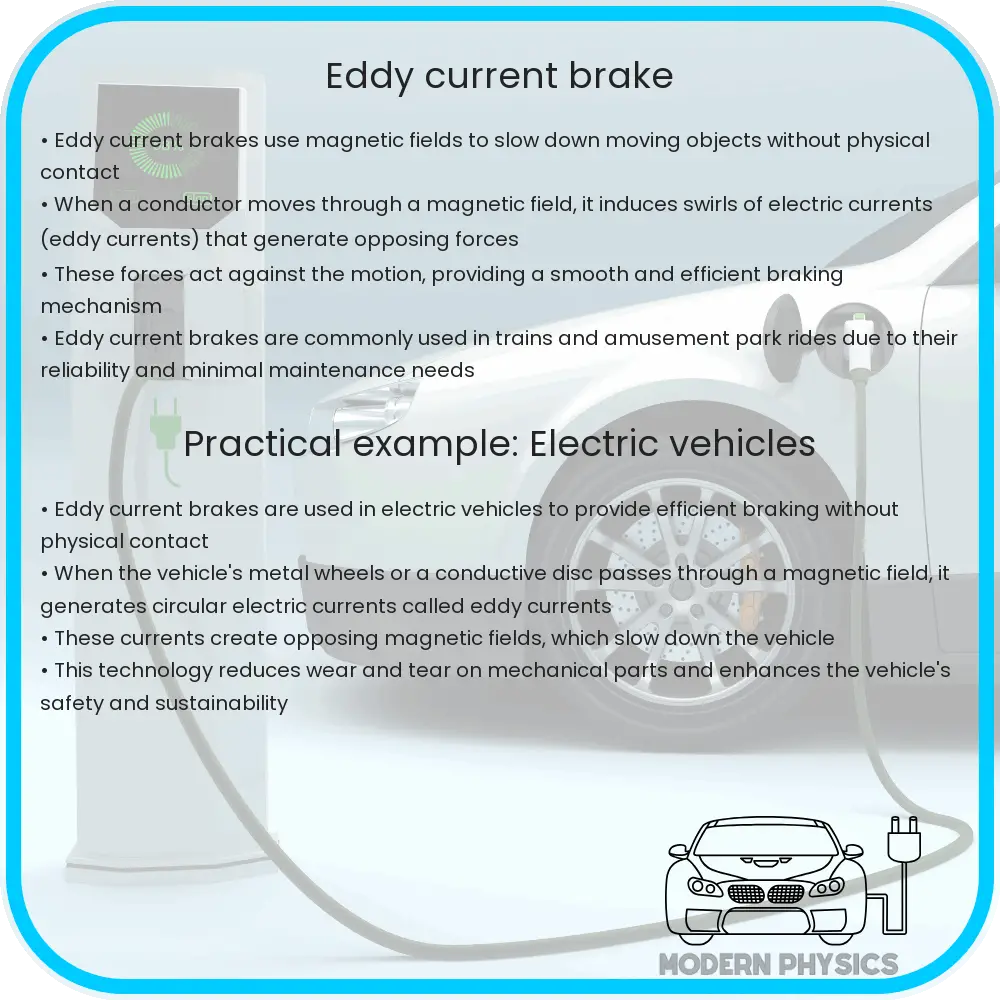Explore the world of Eddy Current Brakes: a safe, contactless, and efficient alternative to traditional braking systems in various industries.

Understanding Eddy Current Brakes: An Innovative Approach to Braking Systems
Eddy current brakes represent a significant leap in braking technology, offering a contactless, efficient, and safe alternative to traditional mechanical brakes. This article delves into the principles and applications of eddy current brakes, underscoring their advantages in various industries.
Principle of Operation
At the heart of eddy current brakes lies the concept of electromagnetic induction, a phenomenon discovered by Michael Faraday in the 1830s. When a conductive material passes through a magnetic field, eddy currents are induced within the material. These currents, in turn, generate their own magnetic fields, which oppose the original magnetic field, according to Lenz’s Law. This opposition creates a drag force, which slows down the moving conductive material without any physical contact. The strength of the braking force can be adjusted by varying the intensity of the magnetic field.
Components and Design
Eddy current brakes typically consist of a set of electromagnets and a conductive rotor or rail. The electromagnets, powered by an electrical source, generate a strong magnetic field. When a conductive material, such as a metal wheel or rail, moves through this magnetic field, eddy currents are induced, and braking occurs. The design is crucial in maximizing the efficiency of the braking system. Factors such as the type of conductor, the strength and distribution of the magnetic field, and the speed of the moving object are considered in the design process.
Advantages Over Traditional Braking Systems
- Contactless Operation: Unlike friction brakes, eddy current brakes do not require physical contact between components. This feature significantly reduces wear and tear, leading to lower maintenance costs and longer lifespan of the brake system.
- Efficiency and Safety: Eddy current brakes offer smooth and predictable braking, crucial for high-speed applications like trains and roller coasters. The absence of friction means less heat generation, reducing the risk of brake-related fires or failures.
- Environmental Benefits: With no friction, there’s no brake dust, a common pollutant associated with traditional brakes. This makes eddy current brakes a more environmentally friendly option.
These advantages make eddy current brakes an appealing choice for industries where safety and efficiency are paramount. In the next section, we will explore their applications and potential future developments in this innovative braking technology.
Applications and Future of Eddy Current Brakes
Eddy current brakes have found their niche in various industries, thanks to their unique advantages. From high-speed trains to roller coasters, their application is widespread and growing.
Key Applications
- Transportation: High-speed trains like those in Japan and Germany utilize eddy current brakes for their efficient and reliable braking capabilities. They provide a significant safety feature, especially at high speeds.
- Amusement Rides: Roller coasters employ eddy current brakes to ensure smooth and safe deceleration, enhancing passenger safety and comfort.
- Industrial Machinery: Eddy current brakes are used in various industrial applications, including conveyor belts and heavy machinery, for controlled and efficient braking.
Future Developments
The future of eddy current brakes seems promising, with ongoing research and development aimed at enhancing their efficiency and applicability. Potential advancements include the integration of smart technologies for more precise control and the use of new materials to improve efficiency and reduce costs. Additionally, as the world moves towards greener transportation solutions, the demand for non-friction-based braking systems like eddy current brakes is likely to increase.
Conclusion
Eddy current brakes represent a groundbreaking advancement in braking technology. Their contactless nature, combined with high efficiency and safety, positions them as a preferable alternative to traditional friction brakes. With applications ranging from high-speed trains to amusement park rides, these brakes not only ensure safety but also contribute to environmental sustainability by eliminating brake dust and reducing maintenance needs. As technology advances, we can expect to see eddy current brakes becoming more prevalent in various industries, marking a significant shift in how we approach braking systems. Embracing these innovative solutions is not just a step towards technological advancement, but also a stride towards a safer, more efficient, and environmentally conscious future.
